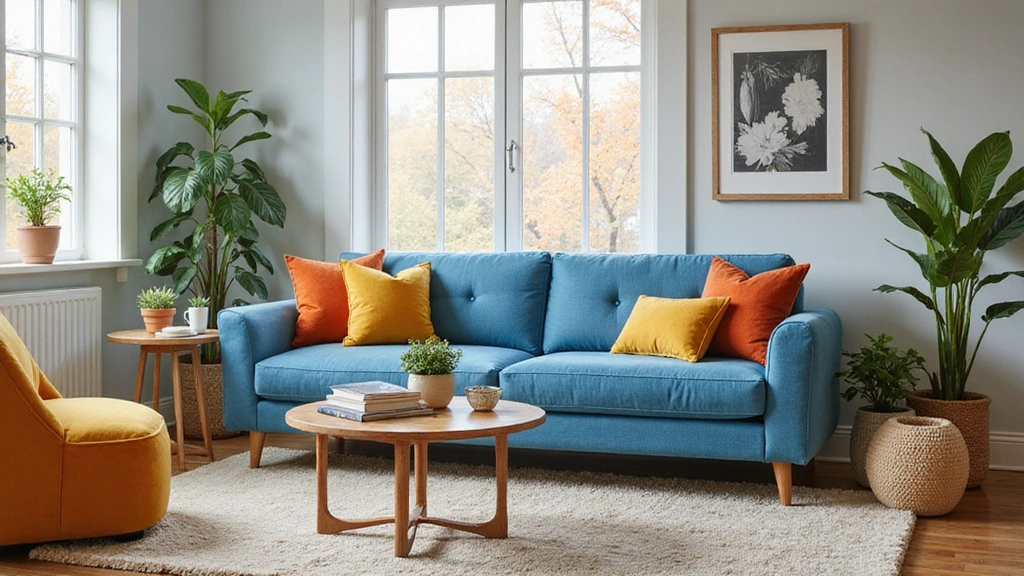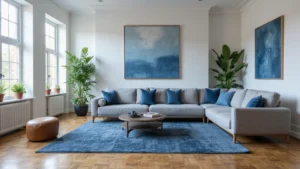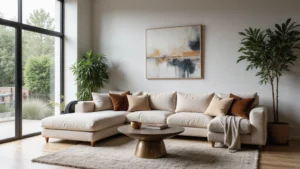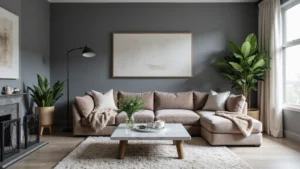In our latest article, “Earthy Living Room Ideas with Natural Wood Furniture and Organic Textures,” we explore how to create a warm and inviting living space that is grounded in nature. Our guide highlights the use of natural wood furniture as a cornerstone, complemented by an earth-tone palette and organic textures.
We delve into the charm of jute rugs, woven baskets, and green plants, which bring both beauty and serenity into the room. Adding stone accents, linen fabrics, and terracotta decor enhances the rustic appeal, making our living rooms feel like a cozy sanctuary.

Join us as we journey through these inspirations to create a truly harmonious haven. Have you ever wondered how to transform your living room into a warm, inviting space imbued with the calming influences of nature? Designing an earthy living room with natural wood furniture and organic textures is an excellent way to achieve this.
Let’s delve into how we can create a cozy and beautiful living room using natural elements and tones.
Earthy Living Room Ideas with Natural Wood Furniture and Organic Textures
Bringing Nature Indoors

First and foremost, we should understand the essence of integrating nature into our living space. Bringing nature indoors isn’t just about aesthetics; it’s a lifestyle. Our home will feel more peaceful and comfy when filled with natural features.


From calming colors to sustainable materials, each element contributes to the relaxed ambiance we seek.
Natural Wood Furniture

When it comes to natural elements, nothing quite rivals the charm of wood. Natural wood furniture imbues warmth and authenticity.

Let’s explore how we can incorporate such pieces into our living room.
Types of Wood
Not all wood is created equal, and picking the right type can make a substantial difference. Hardwoods like oak, maple, and walnut are durable and offer a timeless look, while softer woods like pine give a rustic charm.


We can mix and match different wood types to create a balanced yet dynamic space.
| Wood Type | Characteristics |
|---|---|
| Oak | Durable, versatile, and classic |
| Maple | Hard, light-colored, and fine-grained |
| Walnut | Luxurious, rich, and dark |
| Pine | Soft, rustic, and affordable |

Key Furniture Pieces
Incorporating specific natural wood pieces can serve as focal points in our living room.
A wooden coffee table, bookshelves, and TV consoles are great starting points. Opting for a central statement piece like a reclaimed wood dining table can tie the whole room together in a cohesive manner.
Earth-Tone Palette

Earth tones encapsulate the warmth and simplicity of nature. Using these colors as a base will help us create a serene and inviting atmosphere in our living room.

Color Choices
We should consider integrating shades of brown, green, beige, and gray. These hues complement natural wood furniture and other organic elements perfectly.


Here are some ideal color choices:
| Shade | Description |
|---|---|
| Brown | Warm and grounded |
| Green | Refreshing and natural |
| Beige | Neutral and versatile |
| Gray | Cool and calming |


Wall Colors and Finishes

The walls are a large canvas that we can use to set the mood. Softer neutrals or earthy shades work wonderfully. Textured finishes, such as matte or eggshell, can further enhance the natural feel.

If we’re feeling adventurous, we can add an accent wall with reclaimed wood or stone.
Fabrics and Textiles

Soft furnishings should echo our earthy palette. Think of linen, cotton, and wool in neutral shades.

These not only complement our wooden elements but also add to the tactile experience, making our living room inviting and cozy.
Organic Textures
Textures are crucial in enhancing the organic feel of our living room. They add character and depth, turning a simple room into an earthy sanctuary.
Jute Rugs

Jute rugs are a staple in earthy designs. They are eco-friendly, durable, and naturally beautiful. These rugs can ground our furniture and add a rustic touch.

Plus, their natural fibers feel great underfoot.
Woven Baskets

Woven baskets are both decorative and functional. They provide excellent storage solutions for blankets, magazines, and other living room essentials.

Positioned strategically, they can serve as eye-catching decor elements.
Stone Accents

Natural stones can make a significant impact.
Whether it’s a stone fireplace, a coffee table with a stone top, or simple stone decorations, these elements bring a raw, untouched feel to our space. Stone features are timeless and blend seamlessly with wooden furniture and earthy tones.
Linen Fabrics

Linen is another fantastic organic fabric. Its natural, breathable quality adds a light and airy feel to our living room. Linen curtains, cushion covers, and throws can introduce subtle textures and make our space feel more current yet timeless.
Green Plants

Plants are an integral part of an earthy living room. They purify the air, add life to our interiors, and their green hues beautifully complement the natural wood and earth tones.
Choosing the Right Plants


Selecting the right plants matters. Low-maintenance and hardy varieties are often the way to go for most of us.


Here are some options:
| Plant Type | Characteristics |
|---|---|
| Ferns | Lush, ideal for low light |
| Snake Plant | Hardy and low-maintenance |
| Monstera Deliciosa | Statement plant; beautiful leaves |
| Pothos | Fast-growing; trailing plant |


Placement
Positioning our plants strategically ensures they get the right amount of light and also make a decorative impact. Grouping different plants together can create a mini indoor jungle and serve as a focal point.
Terracotta Decor

Terracotta is synonymous with earthy and organic design. Its rich hues and rustic texture can enhance our living room’s natural ambiance.
Elements to Incorporate

We can use terracotta pots, vases, and decorative objects throughout our living room. Wall-mounted shelves displaying terracotta art can also be a distinctive feature.
Rustic Elements

Rustic elements can imbue our living room with an old-world charm that feels timeless and cozy. These pieces often tell a story and add unique character to our space.
Reclaimed Wood

Reclaimed wood furniture or accents offer a rustic, weathered look.
Furniture pieces like a reclaimed wood coffee table or shelving unit can serve as statement pieces. The fault lines and imperfections in reclaimed wood make each piece unique.
Vintage Finds

Incorporating vintage items can add a layer of history and authenticity. Old clocks, artworks, and intricate rugs sourced from flea markets or antique stores can become conversation starters and elevate our earthy decor.

Incorporating All Elements for a Harmonious Design
Now that we’ve discussed individual elements, the challenge lies in bringing everything together harmoniously.
Here are some tips on how we can accomplish this:
Layering

Layering is key to creating a balanced and cohesive design.
Start with a base of natural wood furniture and earth-tone palette. Gradually introduce organic textures through rugs, fabrics, and decor.
Plants and stone accents should be the final touches that breathe life and vibrancy into the space.
Balancing Texture and Color

Balancing different textures is essential to avoid a cluttered look.
Mix and match smooth and rough textures to keep the space dynamic. Similarly, stick to a consistent color palette to maintain harmony.
Earth tones should be dominant, with accents of green from plants and occasional pops of color from rustic elements.
Creating Focal Points

Every room needs focal points that draw the eye and invite us to explore. A beautiful wooden coffee table, a gallery wall of terracotta art, or a cozy reading nook surrounded by plants can serve as focal points in our living room.
Practical Tips and Maintenance
An earthy living room with natural elements does require some upkeep to maintain its charm. Here are a few practical tips:
Cleaning and Care

- Wood Furniture: Regular dusting and occasional polishing can keep wooden furniture looking fresh.
- Jute Rugs: Vacuum frequently to remove dirt. If stained, spot clean with mild soap and water.
- Plants: Ensure they are watered appropriately and occasionally clean the leaves to encourage efficient photosynthesis.
- Linen Fabrics: Launder as per care instructions, typically in cool water and air-dried to prevent shrinkage.

Sustainable Practices
Adopting sustainable practices can also enhance the earth-friendly vibe of our space. Using recycled materials, opting for eco-friendly cleaning supplies, and being mindful of energy consumption are practical ways to maintain an eco-conscious living room.
Customizing Your Space
Ultimately, our living room should reflect our personal style and preferences. Customization allows us to put our unique stamp on the design.

Here are a few ideas:
- Personal Art: Display personal art or photographs in natural wood frames.
- DIY Projects: Engage in DIY projects like creating a customized terracotta art piece or a reclaimed wood shelf.
- Sentimental Items: Incorporate items that hold sentimental value, adding a personal touch and storytelling aspect to the space.

Final Thoughts
Designing an earthy living room with natural wood furniture and organic textures is a rewarding journey.
This design not only cultivates a warm and welcoming atmosphere but also introduces tranquility and a sense of well-being into our home. By carefully selecting and combining natural elements, we can create a living space that feels harmonious and beautifully connected to nature.
Regardless of our starting point, it’s the thoughtful details and personal touches that will make our earthy living room truly ours.
So, let’s embark on this delightful journey to transform our space into a serene haven imbued with nature’s charm.
Nature awaits us, right in our living room.









